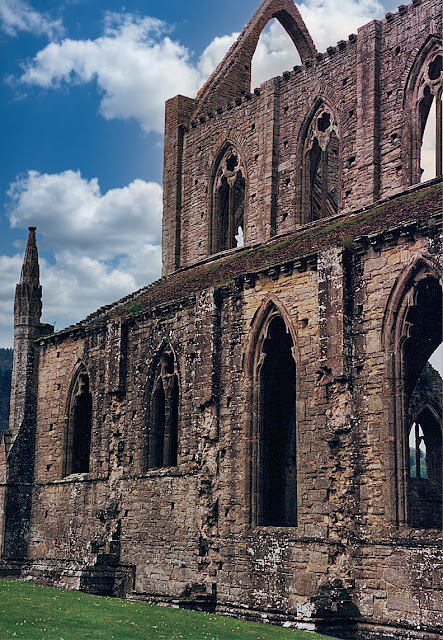Borders
For the final full day in Wales, in 1991, we were finally on schedule, weren't rushed to get to our destination.
From Cardiff, we made it to Chepstow, in the southeast corner of Wales and right on the border with England, and we were able to pitch our tent before we lost light. But the full day in the city that has a family connection, mixed with the earlier drive, from Caerphilly, wore us out and had us call it an early evening. We wouldn't explore the city until the next morning.
We awoke the next morning energized and ready to tackle the day. Time with our rental car was coming to an end and we needed to be in London before the rental agency closed, the following day. And before then, we still had a lot of ground to cover and two more Welsh sites to see.
When we were planning our trip and learned that there was a castle in Chepstow, high on a clifftop over the River Wye, we knew we had to pay it a visit, especially since it was so close to our last planned stop before crossing the border, back into England.
Chepstow is the site of the oldest post-Roman stone fortification in the UK. Built by a Norman lord, in 1067, it saw lots of action during the Welsh rebellions and finally fell into disrepair after the English Civil War of the 1600s.
Too bad the Marquees of Bute didn't take it over.
Here's some trivia: in 1977, Monty Python member, Terry Gilliam, shot parts of his film, Jabberwocky, at Chepstow Castle.
While DW and I stood high above, in the Great Hall, we looked down onto the River Wye and saw boats pulling water-skiers (see the fifth photo, below). Talk about your past and present.
After exploring the castle, we wandered down to the bridge that we could see from the heights of the castle, which borders on the Welsh-English border. We were going to cross that border soon enough, but for now we were going to drive further north along the Welsh side of the Wye, to a famous abbey.
Driving along the A466 and down the hill that leads in to the valley in which Tintern Abbey is situated, we could understand the awe that poet William Wordsworth, and other poets and artists, had felt when they beheld this massive structure. It appears large at first sight and gets even bigger as you get closer and closer.
In its heyday, it must have been remarkable to see.
Founded in 1131 by the Cistercians, there is evidence that places of worship go back centuries earlier. The abbey's end came in 1536, after King Henry VIII dissolved the monasteries in England. The lord of Chepstow took possession and sold off the lead roof, and the building fell into decay.
There were plenty of visitors when DW and I arrived but the church and its grounds are so large, and covers such a vast area, that we often felt as though we were the only ones there.
Our trek through Wales was at an end. We had begun our journey at an abbey in ruins and ended it at another abbey, also left as a shell of its former self. In between, we had seen some awe-inspiring castles, steeped in history, and we had driven over some of the most beautiful landscape that I have ever seen.
Because I was our driver—DW doesn't drive manual-transmission vehicles and didn't feel comfortable driving on the left, so I was the only one insured to drive the Fiesta—I was constantly looking to the right and left as we meandered the peaks and valleys of the terrain, and at times I had to pull over and get out of the car to take in the majesty of it all. I remember, at one point, I was so overcome by the beauty that tears rolled down my cheeks.
Wales is breathtakingly beautiful.
From Tintern Abbey, we backtracked to Chepstow and then crossed over to England, where we made a B-line to Bath.
More to come.

















Comments
Post a Comment